|
|
In Defense of Bach
|
|
By John Reese (June 2004) |
|
The Internet is filled with lengthy treatises by little-known scholars who enthusiastically question "conventional" wisdom. Judging from these resources, there are a lot of people out there who are rigorously opposed to the accepted views of history, cosmology, physics, and even mathematics. Hundreds of people, for instance, believe they have found errors in Einstein's theories of relativity. These claims rarely hold up to any serious, or even casual, scrutiny.
If the so-called "hard" sciences are open to debate, then it is easy to imagine an even greater capacity for dissent in the arts, particularly in music. Although almost everyone enjoys music in one form or another, there are huge gaps in the comprehension of musical forms. Somewhere in between trained musicians and "hip-hop" fans are those who understand music just enough to sound educated, but not enough to make grand, paradigm-shifting assumptions about the cultural and historical contributions of the great composers. Unfortunately, this does not stop them from trying.
In his article, Is Johann Sebastian Bach a Great Composer? Claude Fernandez attempts to make a case that J. S. Bach is overrated as a composer, particularly in comparison to his contemporary, Antonio Vivaldi. Fernandez argues that Bach's notoriety is due to "extra-musical" factors such as ideology, nationalism, and technical expertise, rather than true musical genius. He returns again and again to the argument that "intellectuals" have essentially forced Bach down our throats. His music, Fernandez says, benefits from a sort of inertia in that so much effort has been expended to portray Bach as a great composer that it becomes difficult to argue otherwise.
When hearing such an audacious argument, the first reaction is to dismiss it without a thought. Everyone knows that Bach was a far better composer than Vivaldi was. Right? When pressed to come up with a reason why one is better than the other, though, we may become tongue-tied. Great music is, as the saying goes, like pornography: You can't define it, but you know it when you see it. Knowing that this is the prevailing attitude, Fernandez attempts to attack the pro-Bach attitude in a rational manner. To support his claims, he discusses nine major points (shown here, in no particular order):
1. Vivaldi sells more records, indicating support among the general public, while Bach is discussed more in books, pointing to support from intellectuals.
2. He was not as published as Vivaldi in his lifetime, and not well known outside his province.
3. Bach based his music on numerology, Vivaldi did not.
4. Bach borrowed music from other composers, Vivaldi did not.
5. Bach's music does not have emotional depth.
6. Influential circles of intellectuals idolized him, exaggerating his worth.
7. The most important musicology work in the nineteenth century was done in Germany, not Italy.
8. The name "Bach" becomes symbolic; his music is enjoyed because his name is associated with it.
9. Bach's music was old-fashioned, not innovative.
Is there anything to Fernandez' arguments? Have we truly been idolizing the wrong composer all along? After hundreds of years, is it really time for a paradigm shift? We will see, by examining two questions: First, is Fernandez' premise supported by his arguments? Second, if not, are there any arguments that would support his premise?
Before we continue, I would like to stress that the version of the article that I read was in English, which is clearly not Mr. Fernandez's first language (the original was apparently written in French). In most cases his meaning is clear even if his syntax is not, and at times he states his case rather eloquently. For better or worse, however, it is his ideas and not his expression of them that are under scrutiny here.
Also, my defense of Bach does not amount to an attack on Vivaldi. I like the music of Vivaldi very much. The Trumpet Concerto, with its electrifying third movement, is one of my favorites. I am also partial to the Gloria, which I first sang when I was in high school. Even then, I recognized that there was something slightly "clunky" about his music, but found it refreshing and entertaining nevertheless. I place Vivaldi somewhat in the same category as Schubert, who lacked the technical skill of the great masters but made up for it by a fertile imagination.
Now, we will consider the author's points one by one.
1. Vivaldi sold more records in 1960, and "The Four Seasons" continues to sell well. Meanwhile, Bach's support seems to come mainly from learned writings, meaning that his appeal is intellectual.
It would not surprise me to find that Vivaldi sells more records, but this is an argument from popularity. By the same token, Paul McCartney could be considered a "greater" composer than either Bach or Vivaldi based on record sales. Anyone who has heard the "Liverpool Oratorio" probably believes otherwise. Vivaldi's music is much more accessible than that of Bach to people not familiar with the classics. His melodies are fairly simple, the texture is primarily homophonic, and his harmonies follow predictable patterns. In other words, his works are similar in construction to popular songs.
If we grant the premise, and say that Bach is favored by snooty elitists and Vivaldi by more "authentic" regular folks - so what? This is not a commentary on the quality of the music of either man. Anyone who invokes popularity to support the claim of musical greatness is headed down a slippery slope. The "unwashed masses" have a poor track record for identifying true greatness, or even competence in many cases. This applies just as aptly to the level of notoriety in the composers' lifetimes as it does to modern record sales.
2. Bach was not published as often as Vivaldi in his lifetime, and was not as well known.
This is another argument from popularity, one that reveals a contradiction in Fernandez' logic. The main thrust of his argument is that Bach is regarded highly today because of "extra-musical" considerations, and not because of his talent as a composer. He then invokes his own "extra-musical" explanation to support his opinion that Bach is overrated.
There are many reasonable, non-musical explanations for Bach's poor publication output and notoriety as a composer during his lifetime. First, Bach was so well known as a virtuoso that his fame in this area tended to overshadow his writing talents. Second, Bach was not particularly good at self-promotion, often politically sabotaging himself over perceived slights from authority figures. Third, Bach preferred to write in a style that was considered old-fashioned at the time. Lastly, Bach's priorities were clearly very different from Vivaldi's. While Vivaldi spent most of his time producing works for all of Europe, Bach concentrated more on utilitarian pieces such as the church cantatas of the Leipzig period. When he did submit a piece of music, it was often not to a publisher, but to an influential person who might return the favor with an appointment or other type of political alliance. From a purely practical standpoint, Bach's method seemed to work better: he provided for his family well and left a respectable estate at his death, while Vivaldi died in poverty.
Taken together, these factors are more than adequate to explain Vivaldi's greater success, although success is not necessarily defined as being more popular. One man's success is another man's failure.
3. Bach's music had a strong basis in numerology, making it essentially a sterile intellectual exercise.
This is essentially an ad hoc argument seeking to support the author's belief that Bach's music is austere and lacks feeling. The argument is a groundless one. There is much evidence that Bach's music was influenced by textual imagery, by the work of other composers, by religious conviction, practical considerations, and, of course, by sheer musical genius. Evidence that numerology played any part in Bach's creative process is circumstantial at best. I have no doubt that careful analyof his scores has revealed many "special" numbers. I also believe that, given a sufficiently torturous analysis, it can be found that Bach predicted the assassination of Archduke Ferdinand.
I am highly skeptical of the claim that encoding secret messages in his music was one of the defining sparks in Bach's creative process. Certainly, he could have done this, but the manner of encoding would have to be subservient to the musical ideas. Theoretical analysis of Bach's work reveals nothing that is not explainable in terms of musical, practical, or textual need. Therefore, even if Bach did employ numerology in his works, it was incidental and irrelevant.
4. Bach borrowed from other composers, while Vivaldi did not
Fernandez emphasizes the fact that Bach copied out many of the concertos of Vivaldi, and borrowed some of Vivaldi's ideas, as well as those of other composers. He bluntly accuses Bach of plagiarism. At the same time he claims: "...we do not know any borrowings important in Vivaldi."
The author is here attempting to impose modern sensibilities on eighteenth-century practices. In the baroque period, the intellectual property of music was not as jealously guarded as it is today. Composers frequently borrowed from each other, although it was usually isolated ideas that were borrowed rather than entire compositions. In Bach's case, copying out the entire score of another composer's work was his preferred method of studying that composer's techniques. Had Bach attempted to publish these works as his own it could be considered highly suspect (and foolish, since Vivaldi's music was popular and well known!). As it was, they were copied for Bach's own edification.
The Vivaldi revival in the nineteenth century began with the discovery of Bach's transcriptions of Vivaldi concertos. If Bach intended to "steal" this music, then how do we know Vivaldi is the original composer? He was more completely forgotten than Bach. How were these pieces recognized, unless Bach freely acknowledged the identity of the true composer?
Fernandez' argument that Bach was a plagiarist (he remarked, "the Cantor would be more often a compilator than a creator") is supported by a number of dubious or misleading claims. He says, for instance, that the theme of the Passacaglia and Fugue in C minor was taken from a composition of Raison. This is only partly true. Bach expanded Raison's four-bar theme to eight bars, and developed it with a skill that few composers in history could equal. Besides, it is likely that Raison borrowed the theme as well - from the chant "Asperges Me".
He also questions the authenticity of the Toccata and Fugue in D minor - in fact, claiming that it is now known for certain that it is the work of another composer - based entirely on the findings of Yo Tomita. Before I would accept this claim, I would have to be convinced that Tomita's conclusions are more valid than those of virtually every other musicologist out there. Also, Fernandez' claim that the Toccata and Fugue is Bach's "most famous masterpiece" is highly debatable. If it were found that it was not the work of Bach after all, it would hardly put a dent in the reputation of the great composer.
As for Vivaldi being innocent of this "thievery" - it simply isn't true. The “Cum Sancto Spiritu” that concludes the Gloria in D was taken from the manuscript of another composer (Giovanni Maria Ruggieri), presumably because Vivaldi had little faith in his abilities to write in the strict contrapuntal style required. Vivaldi did improve the piece by his modifications, but the basic structure and texture of the piece was lifted in toto. This is much closer to the modern concept of plagiarism than borrowing four bars of notes.
5. Bach's music lacks emotional depth
It is actually quite difficult to determine what point Fernandez is making in this section. He says that Bach's religious music sprung from unmusical ideals, that it appeals to the "traditional public" because it lacks passion and virtuosity (it actually contains a considerable amount of both). He quotes musicologist Alberto Savinio, who felt that Bach's music (and that of other "ancient" composers) lacks emotional depth, to support his claims. He then backs away from the entire argument by saying it is only one man's opinion.
Once again, Fernandez reveals a lack of internal consistency. Is Bach a popular favorite, or isn't he? How is this "traditional public" that hates passion and virtuosity different from the buyers of Vivaldi recordings? And wouldn't have Savinio, who is quoted as saying that the success of ancient music was a "manifestation of collective cowardice", been opposed to the music of Vivaldi as well?
Based on this section, it appears that Fernandez doesn't understand the point of absolute music. Emotional depth is not necessary in the creation of great music. Certainly, it may stir emotions in the listener, but it occupies an entirely different realm than that of emotion. There are also times (particularly in the case of vocal music) when it is appropriate or necessary for the music to convey deep human feelings. However, music (if it is written well) can be enjoyed independently of this emotional connection.
6. Influential circles of intellectuals idolized him, exaggerating his worth
Here the claim is made that Bach is considered a great composer simply because stolid intellectuals say he is. This, of course, directly contradicts the argument that Bach appeals to the "middle class" and to the "traditional public", whatever that means. Just how far does this secret society of intellectuals extend? If it is really that far reaching, then the argument boils down to this: "Bach is regarded as great because many people regard him as great." If there is a more excruciatingly circular argument out there, I have yet to see it.
Fernandez goes further to say that the opinions of the "intellectuals" in question are in error because they are exaggerated. Let us examine some of the quotations used to illustrate the author's point:
At Cambridge in the 1840, T.A. Walmisley lectured on Bach and taught his students to revere him above all other composers. (New Grove Dictionary of music and Musicians, Macmillan Publishers Limited, London,1989)
But what makes his over-whelming superiority on all composers of his age, is the deep sensitive character who changes his most formalistic scores. (Vuillermoz Émile, Histoire de la musique, Fayard, 1973, première édition de 1949, p 140)
Never a musical organisation stronger, more perfect than that of the Cantor of Leipzig has lived in the skull of a mortal (Rebatet, Lucien, Une histoire de la musique, Laffont, Paris, 1969.)
To-day, everybody knows that his name is one of a musician that none overtakes, that none probably equals. (Aguettant, Louis - La musique de piano des origines à Ravel - Albin Michel, Paris, 1954 - p. 51)
The greatest composers are severely criticized : none perhaps, except Bach, is spared. (Mauclair Camille, La religion de la musique, Librairie Fishbacher Paris 1908 environ, p. 104)
That I admire and that always astonished me in Bach is exactly this musical feeling thick, concise and inexhaustible of all his masterpieces. (Buchet, Edmond, Connaissance de la musique, Editions Correa Paris 1942, p. 161).
Fernandez then utterly fails to explain the relevancy of all these quotations, except to say:
It appears that many recent Music History books, and even dictionaries, generally respecting the objectivity of scientific books introduce as Pavlovian reflex about Bach judgments of value. The terms sublime, genial, wonderful, marvellous are used even though they are generally not used for Vivaldi and most other composers. The idolatry about Bach since his revival cannot be contested. The exaggeration of these overstatements, sometimes through a religious vocabulary incites to be prudent and not believe these speeches.
Fernandez does not explain why we should not believe them, other than his claim that the "overstatements" are "exaggerated". Redundancy does not equal truth. Certainly, the quotations make use of a flowery, perhaps even "religious" vocabu, but this is not the same as being exaggerated, unless one has read them with preconceived antipathy towards Bach. He then goes on to say:
On the other hand, Vivaldi has never represented a myth, he is apparently known because his music is really appreciated, it is the reason why he represents - contrary to the opinion of most of commentators - a more solid and authentic value.
No support is offered for this statement. We must simply take the author's word for it.
7. The most important musicology work in the nineteenth century was done in Germany, not Italy
Throughout the article, Fernandez betrays a bias towards Italian and against German composers. Whether these preferences are actually based on nationalism or the two countries are serving as surrogates for the two composers in question (Bach and Vivaldi), the argument is made that cultural differences play a part in the perceived favoritism towards Bach and consequent snubbing of Vivaldi. Germany "won" the battle of which would be considered greatest, the author claims, because there was a greater interest in musicology in Germany than in Italy. However, if this were the case, why would anyone outside of Germany take an interest in the musicological work of the Germans? Why would the Italians, for instance, fall for the accepted wisdom of Bach being the greatest composer? And why Johann Sebastian in particular, rather than any of the other well-known German composers bearing the name of Bach?
The truth is that Vivaldi was forgotten in Italy after his death, and not just by musicologists. Although Bach's work was largely neglected, a small but devoted Bach following persisted in the years after his death. The Well-Tempered Clavier, for instance, was well known among late-eighteenth and early-nineteenth century pianists despite the fact that it was never published in Bach's lifetime.
8. The name "Bach" becomes symbolic; his music is enjoyed because his name is associated with it
Fernandez invokes here a sociological theory surrounding primitive cultures and the fact that the "totem" or other idolatrous symbol is not the actual focus of worship, but merely serves as a conduit. His argument is that the music of Bach is not the subject of adoration, but serves the same function as a primitive totem. Here, enthusiasm for Bach is described to as a sort of conditioned reflex, with Bach's music being symbolic of Bach, the hero. I would suspect that this is only true of Bach lovers of limited musical literacy, who do not really understand his music but behave as they are expected when they hear it. I don't doubt that there are many people like this, but their opinions are hardly necessary to maintain Bach's reputation, which originates from those more proficient at understanding the complex subtleties of his music.
This argument is a variation of one already made, that love of Bach is idolatrous rather than deserved. Restating the same arguments in different language is not particularly convincing to me.
9. Bach's music was old-fashioned, not innovative
It is true that Bach preferred older forms to the more popular galant style of his contemporaries (although he was perfectly capable of writing in this or any other style). This may have been in part because of his great skill at counterpoint, which would have gone to waste had he concentrated on homophonic textures as much as Vivaldi had.
However, Bach was capable of being innovative within the boundaries of this older style. Most of the truly innovative work was done, naturally, when he was a comparatively undisciplined youth. However, throughout his life his instrumental writing was extremely daring, pushing the capabilities of the instruments to their limits. This is particularly true of his violin, clavier, and organ works. Later in life, he took the art of counterpoint further than anyone before him had dared when he composed the Musical Offering and Art of the Fugue. His use of chromatic harmonies in these works was quite unlike anything heard before. In short, while it may be accurate to say that Bach was old-fashioned, it is wrong to say he was not innovative.
Most importantly, it really doesn't matter what style Bach preferred, for his work is endowed with a musical depth that transcends stylistic fashions. In whatever milieu he chose to create, the high levels of craftsmanship gave his music a universal quality that rings as true today as it did hundreds of years ago. Fernandez is free to characterize this as an exaggeration, but I plan to support my statements in due course when I elaborate on the definition of "craftsmanship".
In full, Fernandez' argument seems a little simplistic. I would guess from his observations that he is a musical dilettante, with just enough knowledge of the two composers and their musical era to appear to be well spoken on the subject. However, many of his arguments fall short of thoughtful analysis. The reader often must make leaps of faith to accept his views. He says often that Vivaldi's music is more "simple" and "pure", and is therefore superior to that of Bach. He throws out words like "solid" and "authentic" to describe Vivaldi. What does this mean, exactly? Even if we agree that Vivaldi's music has these qualities, it doesn't follow that being simple, pure, solid, and authentic is inherently better. By the same token, greater complexity doesn't necessarily entail greater music, but it does provide a superior opportunity for depth in a composition. The great composers, such as Mozart, who primarily used a simple, elegant style were still capable of producing more complex music when the need arose (As an example, look at the Mozart's Requiem or the fourth movement of the Jupiter Symphony). Vivaldi, as we have seen, was forced to borrow the music of another composer.
The author also seems to think that music lovers are divided into "pro-Bach" and "pro-Vivaldi" camps. This is not true. Many Bach lovers also enjoy the music of Vivaldi. There is no conflict in this. In my view (as will be demonstrated later), Bach's music shows a far greater level of expertise than that of Vivaldi. This, however, does not mean that I don't appreciate the work of the Italian master. In fact, Bach clearly appreciated it as well, since he took the time to study Vivaldi's scores. (One of the character traits I have long admired about Bach is his humility, demonstrated by his willingness to learn from other, lesser artists.)
Fernandez makes his biggest mistake in claiming austerity and dryness in the music of Bach by pointing to his frequent use of counterpoint. This directly contradicts his opening arguments, that Bach's notoriety is based on "extra-musical" factors. If counterpoint is not musical, then what is it? The rules of counterpoint apply to nothing else but music. They are meaningless in any other context, mathematical or otherwise. The view that it exists somehow outside of music, in a purely intellectual realm, is faulty.
So, what does that leave us with? It should be clear that Mr. Fernandez' claims are neither internally consistent nor solidly backed by his reasoning and the examples he has provided. This, however, does not mean that his conclusion is wrong, just unsupported. With this in mind, we must ask the question: How do we know that Bach is a greater composer than Vivaldi? If it were simply a matter of personal preference, then Mr. Fernandez' assessment of Bach would be perfectly valid. However, the fact that he considers the opinions of Bach lovers to be invalid indicates that he, at least, believes that there is a standard against which both composers can be judged. And so do I.
First of all, we must dispense with the word "great" to describe the composers' work, for it describes a social abstraction that is impossible to demonstrate or prove. Whether or not someone is considered great depends as much on luck - being at the right place and time in history - as it does on ability. We must therefore look to a more rational basis for comparison. For the sake of argument, I believe it is better to ask: Was Bach a better composer than Vivaldi? How can we objectively make that determi? What quality would one person have that would make him a better composer than another? The answer, in a word, is craftsmanship. The meaning of craftsmanship in music composition will be discussed next. |
| |
|
Craftsmanship in Music Composition |
|
The elements that constitute good craftsmanship in a composer are impossible to define with complete objectivity, but most authorities would agree that a few skills are essential:
1. Knowledge of technical musical conventions and the ability to apply them consistently
2. Expertise in the three dimensions of musical texture - monophony, homophony, and polyphony - and the ability to apply them when appropriate
3. Expertise in the three dimensions of instrumentation - the sound of individual instruments, the limitations and capabilities of instruments, and the blending of different timbres together.
4. Ability to produce novel musical ideas on both small and large scales.
5. Ability to take musical ideas and develop them to the fullest extent.
6. Ability to create in a variety of genres.
All of these skills carry with them the underlying assumption that they will be applied in a balanced and coherent fashion. All good composers understand implicitly the expectations of "the ear" (or more accurately, human aural perception) and can use the techniques described above to both meet and, where appropriate, exceed these expectations. The real trick is in finding a balance between the familiar and the novel, without becoming mired in one or the other.
The first skill on the list requires merely that the music be "grammatically" correct, while the second and third require the ability to use technical expertise in a manner that is both coherent and varied. In other words, number 1 deals with musical syntax (which, of course, changes over time), while numbers 2 and 3 are more concerned with musical semantics - the "meaning" of a piece within a purely musical context.
Musical ideas can be either small scale - as small as the "three shorts and a long" motif used by Beethoven - or large scale, such as Verdi's approach to the Requiem. It is tempting to put 4 and 5 together - "Ability to produce novel musical ideas and develop them to the fullest extent". However, a good composer keeps these disciplines separate. It should not matter what the source of the musical idea is, as long as the composer can take it and do something with it. In a like manner, a finely crafted musical idea can be taken and developed easily by another composer, the creativity of one artisan sparking that of another (for instance, Brahms' Variations on a Theme by Haydn).
While the three "dimensions" of musical texture are well known, the concept of three instrumental dimensions is my own:
- A composer with skill in the first dimensiion can choose an instrument that is aesthetically appropriate for the part it is to play (or, if instrumental resources are constrained, writing music appropriate for a given instrument). This is the most basic (and necessary) skill a composer should have with regards to instrumentation. It includes the importance, in vocal writing, of matching music with the text.
- Second dimension skill involves knowing ennough about the instrument not only to avoid exceeding its capabilities, but also to fully exploit its capabilities, testing the limits when appropriate.
- Third dimension skill is related to what wwe call "orchestration" today. A composer should be able to put different combinations of instruments together in a pleasing fashion, or at least in a way that does not send the audience scurrying for the exits. Composers in the baroque period would generally score relatively poorly on this skill (although very few emptied out the seats), since the "orchestra" as we know it did not exist then.
Finally, the sixth essential skill involves the flexibility of the composer. Does he try out a variety of different musical styles, or stick to the tried and true? This not only applies strictly to style, but to structure as well, which often goes hand-in-hand with a particular genre (for instance, the Sonata-Allegro form is strongly identified with the Viennese Classical school).
There is another quality that may tip the balance when trying to determine the relative strengths of different composers. This quality is not related directly to craftsmanship, but has a more historical relevance. It is the ability to pioneer new musical forms and philosophies, to push other composers into new ways of thinking. Clearly, Vivaldi has the edge here. He was one of the true pioneers in the art of concerto writing (and through it, orchestration), and his influence continues to this day. |
| |
|
Comparing Vivaldi and Bach |
|
Next we will attempt to evaluate the craftsmanship of the two composers by comparing similar compositions according to the "apples to apples" philosophy. This comparison is not always fair, since Bach spent most of his time on sacred choral music, while Vivaldi devoted himself to concerti. However, a comparison of a vocal piece and a concerto movement from each composer should provide a clear enough picture.
First, we will look at an aria from each composer, the "Qui Sedes" from Bach's B minor Mass, and the corresponding section from Vivaldi's Gloria. The two pieces are intriguingly similar. They are both arias for alto, both are in the key of B minor, they both make use of compound meter (3/8 for Vivaldi, 6/8 for Bach), and they are approximately the same length (converting the 6/8 time to 3/8 for comparison, Bach's piece is the equivalent of 176 measures long to Vivaldi's 150). The voice part in each begins in almost exactly the same way, going from the pickup B-natural on the syllable "Qui" down to F-sharp on the first syllable of "sedes":
Vivaldi: |
|
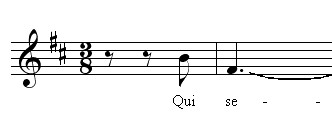
|
|
Bach: |
|

|
|
In both cases, sustained notes in the voice are accompanied by rhythmic movement in the strings:
Vivaldi:
|
|
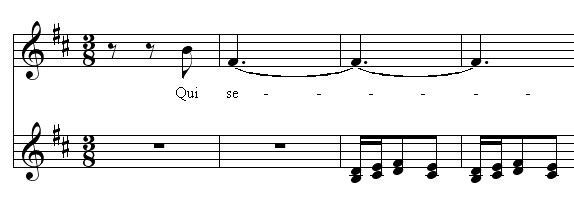
|
|
Bach: |
|
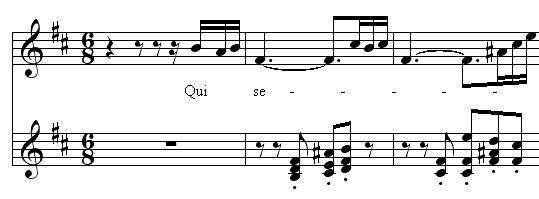
|
|
In each of the pieces, an "echo" effect is used between the voice and accompaniment:
Vivaldi:
|
|

|
|
Bach: |
|
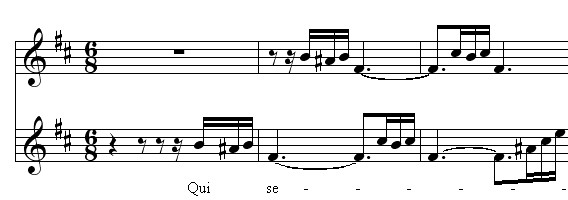
|
|
Here, the similarities end. The two pieces are of a very different character. Vivaldi's is raucous and fiery, while Bach's is serene and tranquil. Bach's instrumentation is more involved than Vivaldi's, which, in turn, results in a greater level of polyphony.
So which piece shows greater craftsmanship? Let's go through the list:
1. Knowledge of technical conventions and the ability to apply them consistently
The comparison is made easier by the fact that both men used an almost identical musical syntax. I would say that both composers are characteristically sound in this department, although in Vivaldi's case the task is much easier. Bach's use of harmony and modulation is more sophisticated than his contemporary's. Without taking into account the different inversions, Vivaldi uses 18 distinct chords in his piece, to Bach's 24. Bach's aria also modulates more frequently, even during the opening ritornello.
2. Expertise in the three dimensions of texture
As mentioned before, Bach makes greater use of polyphony in his piece, although it is essentially a homophonic aria. Vivaldi seems to avoid any hint of polyphony as if it were an infectious disease. As with much of his music, Vivaldi has one voice fall silent as another comes in, and the bass becomes greatly simplified if anything of importance is going on above. This is not an indictment in itself, for Vivaldi wrote in a style that did not favor counterpoint. His intent was to focus the listener's attention on a single melodic line, rather than to absorb the whole as is necessary with Bach. However, as stated earlier, we know that when a fuller counterpoint was called for, Vivaldi did not judge himself up to the task.
3. Expertise in the three dimensions of instrumentation
In Vivaldi's Qui Sedes, the accompaniment consists of basically the strings and continuo. Bach adds an oboe to this mix, providing the obbligato so that the strings are free to produce harmony. They fill this role only scain Vivaldi's aria, leaving the continuo to fill in the harmonies.
The telling point here is in the vocal declamation and the music's appropriateness to the text. While Vivaldi seems to focus on the first part of the liturgical text, "Qui sedes ad dextram Patris", ("You who are seated at the right hand of the Father"), while Bach focuses on the final phrase, "miserere nobis" ("Have mercy on us"). This would explain the differences in the character of the two pieces. While Bach's approach makes the music appropriate for the entire text, Vivaldi is left with a jaunty, toe-tapping tune as he pleads "have mercy on us": |
|
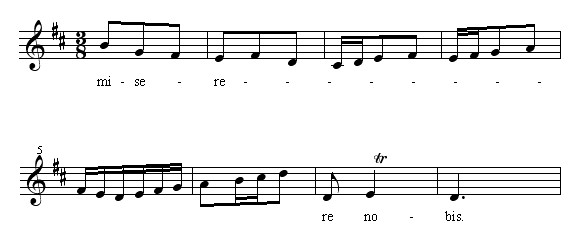
|
|
A comparison between Bach's and Vivaldi's treatment of this particular phrase puts one of Fernandez' primary arguments -- that Vivaldi was emotive while Bach was purely mechanical -- into serious doubt.
4. Ability to produce novel musical ideas
Here, Vivaldi is at his strongest. His music is full of what popular musicians call "hooks", intriguing little musical nuggets that grab the listener's attention. As in popular music, these ideas are brief and to the point. It is partly because of his ability in this area that Vivaldi has been able to overcome some technical shortcomings and still be remembered centuries after his death. The music in Vivaldi's aria is derived mainly from these themes: |
|

|
|
...and... |
|

|
|
...and... |
|

|
|
...finally, |
|

|
|
The musical ideas of Bach tend to be more complex and thoughtful. Instead of being thrust upon the listener in quick succession, they unfold slowly and majestically. They are less predictable than Vivaldi's, both melodically and harmonically, but follow a logical progression that keeps the listener absorbed. Bach's setting contains two fairly complex themes derived from the motif, shown above, that introduces the voice part: |
|

|
|
...and, |
|

|
|
Consider the opening phrases in the voice part of each aria. Vivaldi's begins in B minor and ends a few measures later with an authentic cadence in the same key. Bach's phrase is more involved, ending in a half-cadence in D major. This means, essentially, that while Vivaldi has launched his piece with a complete (albeit brief) musical thought, Bach has merely laid the groundwork for what is to come. His music leaves the listener with a feeling of anticipation, which enables Bach to create more complex structures without becoming overly pedantic.
Bach's aria also includes three smaller musical ideas, two of them in the string ensemble: |
|

|
|
...and, |
|

|
|
These two are rhythmic ideas, adaptable to a number of different harmonies.
The third idea: |
|

|
|
Is a snippet of music that hardly qualifies as a melody; it occurs near the end of some of the phrases as part of the cadence. It will be discussed at length in the next section.
5. Ability to take musical ideas and develop them to the fullest extent
A composer can make up for deficiencies in his basic ideas by demonstrating proficiency in developing them. One of the marks of a truly gifted composer is his ability to take a seemingly insignificant musical idea and develop it into a significant section of the piece. Bach does this with the last motif shown above. At the climactic moment, he brings this idea to its full fruition, introducing it in the voice, then imitating it in the strings, then the oboe: |
|
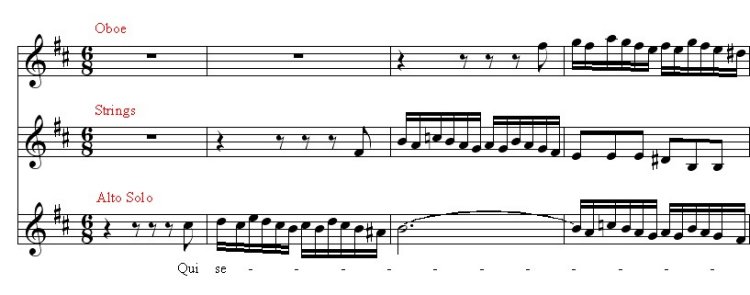
|
|
Not only is this section finely crafted, it is exquisitely poignant, belying once again the notion that Bach's music lacks expression.
Does anything comparable happen in Vivaldi's "Qui Sedes"? Regrettably, no. As mentioned before, the musical ideas are brief and to the point, they are stated (sometimes repetitiously) then dropped in favor of the next theme. Restating them in a different key is often the only form of development Vivaldi employs. As is often the case with Vivaldi, imitation takes the form of strict repetition. This is natural for a composer who specializes in the antiphonal techniques in his concertos. However, it would have elevated Vivaldi's standing among composers considerably had he demonstrated the ability to stretch beyond his usual habits. This would appear to strike a blow against Vivaldi in skill number 6, "Ability to create in a variety of genres", but it would be unfair to pass judgement on the basis of a single composition. |
| |
|
Musical Mannerisms and what They Can Teach Us |
|
Before going on to the concertos, let us step back to look at the work of the two composers from a larger perspective. Both Bach and Vivaldi had certain mannerisms that are evident in their music. There were certain chord progressions, certain melodic nuances, and other clearly identifiable compositional devices that each composer had the habit of using. Identifying and comparing these musical mannerisms may help further determine the difference in skill level between Bach and Vivaldi. As in any discipline, composers can develop both good and bad habits. If a composer habitually employs devices that are too obvious and rigid, then their repetitive use will make them seem cliched to the listener. However, if they are subtle and flexible, they are capable of generating a very rich tapestry of musical ideas.
Vivaldi's Mannerisms
Circle of fifths progressions: Vivaldi had an inordinate fondness for the circle of fifths chord progression. It appears often in his works, usually with the chords in root position: |
|

|
|
This device is useful because it creates a recognizable pattern that the listener can latch onto, and it greatly facilitates the use of sequences in the melody. The harmonic "flow chart" used by most eighteenth century composers was built around this chord progression, as it is what the ear naturally anticipates. For this very reason, composers must take care not to overuse it.
Hemiolas: Vivaldi also made frequent use of the hemiola - the temporary "stretching" of two triple-meter units into a single unit with doubled beat durations. Often used towards the end of phrases, his hemiolas are anything but subtle. The new beat references are strongly emphasized to make it clear that this is an intentional rhythmic anomaly. It's as if the listener is told: "Here comes the HEMIOLA!" Several examples of this are found in the Qui Sedes: |
|

|
|
Bach used this device in his Qui Sedes as well, but his use was much subtler: |
|

|
|
Verbatim Imitation: Another commonly used device with Vivaldi is verbatim imitation - in other words, imitation at the unison. The listener essentially hears it as the same passage being repeated (and often, that's exactly what it is), although sometimes the two melodies overlap each other, as seen in another section of the Gloria: |
|

|
|
As mentioned previously, this practice arose naturally out of Vivaldi's frequent use of antiphonal relationships in his concertos. When he wrote for dual instruments (such as a concerto for two recorders) the two instruments often echoed each other with this type of imitation.
Harmonically Inclined Slow Movements: Listening to a Vivaldi slow movement often creates a déjà vu feeling. Although the music itself can vary from one composition to another, there is something about these movements that seems very familiar to Vivaldi listeners. That "something" is a strong focus on harmonic progression. Technically, these movements are homophonic, but the melody is subordinate to the harmonic structure, and often defined by it: |
|
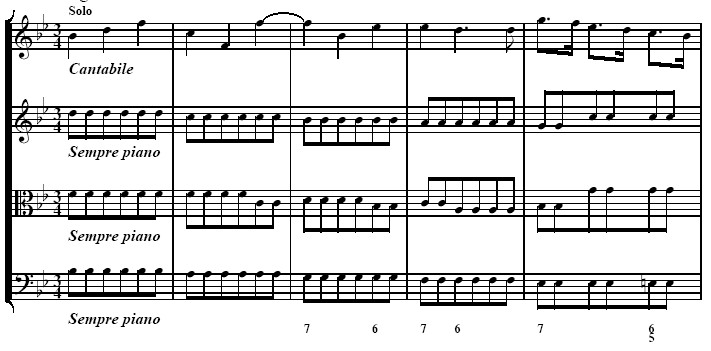
|
|
(Vivaldi, Opus 4, No. 1)
The listener becomes awash in a slow but relentless pulse of harmonic progressions, with the changes providing much, if not all, of the variety. He made liberal use of secondary dominants in these movements. The structure is one of great homogeneity, without clearly divided sections. This tactic has been used successfully by many composers, including Bach imany of his preludes. The first movement of Beethoven's Moonlight Sonata is a famous example.
Bach's Mannerisms
Composite Melodies: Bach's melodies often seemed to be influenced by his organ-playing. One type of melody, which I call "composite melody with pedal tone", occurs frequently and in a great variety of ways. The most famous example is perhaps the fugue subject from the Toccata and Fugue in D minor. Here, Bach wrote a melody that could be played fairly easily on the pedals. The right foot would play a repeating A, while the left foot would move down the scale, interleaving notes with the ones played by the other foot:
|
|

|
|
Or, if you prefer to believe, as Fernandez does, that this is not an authentic Bach composition, the same technique is used for the subject in the fugue in A minor: |
|

|
|
Bach did something similar in the "Qui sedes": |
|

|
|
This is a composite melody with a pedal tone on the B. The lower melody plays a sequence, but returns time and again to the point where it started.
The other melody |
|

|
|
turns the concept upside-down, with the lower melody taking the pedal tone (on F#) and the upper moving away from it.
Declamation Anomalies: In his vocal works, Bach was very conscientious about declamation - writing music that complemented the natural rhythm of the spoken word. Often, however, he spiced up his declamation by ending a phrase like this: |
|

|
|
The final syllable here should not be emphasized, but Bach kept it from dropping into a "black hole" of sound by adding this little flourish. In the "Coffee Cantata", he toyed with the weak syllables in a different way: |
|

|
|
Compare this to Vivaldi, whose treatment of strong and weak syllables is often simply - wrong. This is particularly true in the scaled-down reprise of the Gloria's opening chorus used for the setting of "Quoniam tu solus Sanctus": |
|

|
|
Here, weak syllables fall on strong beats, while strong syllables fall on weak beats, particularly in the last two measures. The clumsiness of this section was obvious to me even as a high school student.
Compulsive Variation: For a composer of his prodigious output, Bach was, by all measures, strongly disinclined to repeat himself musically. If he adapted music previously written music for a new occasion, he almost never copied it verbatim, and sometimes made subtle alterations to the basic structure. More importantly, he often avoided repeating himself within the same piece. Unlike Vivaldi, who found it sufficient to simply transpose a section to a new key when re-using it, Bach added to the richness of his music by enhancing the repeated section on one way or another. Take the following examples from the "Little" G minor fugue. First, there is a typical Bach expression of a circle of fifths chord sequence: |
|

|
|
A variation of this sequence returns later: |
|
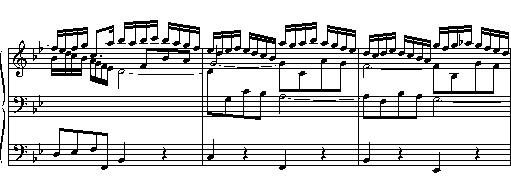
|
|
...and finally: |
|

|
|
As you can see, Bach did not find it sufficient to vary the starting point for his circle-of-fifths progression (D minor in the first sequence, F Major in the second, and C minor in the third). He made use of invertable counterpoint between the first and second episodes, swapping the top and bottom lines, then revealed a completely new variation in the third.
Postscript Phrases: Bach also employed deceptive phrase followed by a sort of musical postscript, as if to say "Oh, by the way, there's more". Instead of concluding where the listener anticipated it, a sort of postscript phrase was appended at this point. This was one of the ways in which Bach was able to draw out a melody, further developing and broadening it. It also helps reinforce the base key of the piece in the listener's mind. Such passages usually begin as a cadence that is slightly "off", like the aborted landing of an airplane that doesn't quite line up to the runway. A fine example is found in the opening prelude of the first Well-Tempered Clavier. |
|
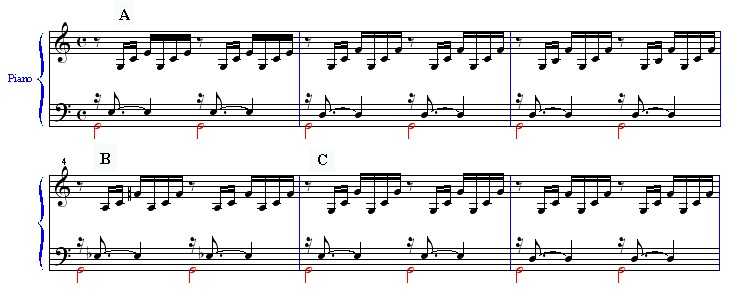
|
|
The chord sequence that leads up to what the listener expects to be the ending is slightly imperfect. The third of the C Major chord in second inversion, leading to the final authentic cadence, is doubled (A). After a deceptive cadence (B), the fingering is effectively realigned so that the chord sequence can be approached from a more advantageous vantage point. A second chord sequence, similar to the first, then makes an appearance, this time without the doubling of the third (C). The prelude can then be concluded in a harmonically more pleasing manner. (It may seem somewhat extreme for Bach to pay such close attention to tiny details, but he did it all the time. It was, to judge from his music, second nature to him. )
Similar passages occur in the Qui Sedes, the Brandenburg Concertos, and many of the arias from the cantatas.
One of Bach's favorite musical postscripts was the chromatic chord sequence at the end of a piece. This was so frequently used by Bach that it became ubiquitous without seeming cliched. It usually followed a more or less set pattern. Beginning with a dominant seventh on the pickup beat, the bass falls to a pedal tone over which is played some variation of the following sequence: secondary dominant seventh to the sub-dominant/sub-dominant/diminished seventh on the leading tone/tonic. Here is a classic example from the Well-Tempered Clavier: |
|

|
|
Use of the pedal tone ensures that the phrase is heard as an elaboration of the tonic, an extended dissonance that is resolved in the final chord. Bach was by no means the only composer to use this technique, but he employed it more often and more skillfully than did any other composer.
Harmonic Crescendo: Many composers have used what is called the "rhythmic crescendo", which is a method of heightening tension by subdividing the beats into smaller and smaller values as the piece progresses (Pachelbel's famous Canon is a well-known example, as is Bach's Passacaglia). Bach went a step further, however, and used a "harmonic crescendo", making more frequent use of harmonic elaboration to build tension, usually towards the end of a middle section in A-B-A form. By the end of such a crescendo, the harmonies often become downright bizarre - a series of diminished-seventh chords, for example, forming a harmonic foundation for an oddly distorted variation of a previously heard theme. Bach used the following chord sequence in the C Major prelude mentioned earlier (dispensing with the arpeggio patterns, which we have already seen): |
|

|
|
The harmonies here become increasingly dissonant, going from a C major chord to a C dominant seventh, then an F major seventh, then a pair of diminished-seventh chords.
Some of the mannerisms of both composers have been seen in the pieces already shown, and more can be found in the two concertos to be discussed. The point of this exercise is to draw a connection between a few isolated pieces of music and the complete catalogs of the two composers. That is, some of the points made about these specific pieces can be extrapolated to apply to most, if not all, of the works of Bach and Vivaldi.
Without further diversion, let us take a look at the concertos. |
| |
|
Comparing Vivaldi and Bach, Part 2 |
|
It took some serious thought to decide which two instrumental pieces would best represent the efforts of Bach and Vivaldi and provide a fair basis of comparison. I finally decided on the opening movement of the first concerto from The Four Seasons, since it is one of Vivaldi's best-known works. By Fernandez' standards, this should therefore qualify it to be one of his highest-quality works as well (in fact, it is). I then chose a work of Bach that was similar in style and instrumentation, the first movement of the third Brandenburg Concerto. We will see how they compare.
First, it should be pointed out that there is a crucial difference between the two pieces: Vivaldi's concerto is program music, intended to represent the coming of Spring. Ba's concerto is absolute music, not representative of anything but the music itself. For purposes of the comparison, we will avoid as much as possible discussion of Vivaldi's interpretation of the program, his use of imagery, and other factors that are irrelevant to the comparison. A well-crafted piece of program music can also be viewed as absolute music, independent of the program on which it was based.
(Lest anyone think I am ignoring a crucial point of comparison by leaving musical imagery out of the analysis, I will say that Bach's expertise in this area is well documented in the mounds of literature written about the cantatas. Such a comparison is outside the scope of this analysis, unfortunately. )
There are a couple of novel structural items in the first movement of Vivaldi's Spring concerto. First, although it is made up of a primary theme and a number of secondary theme groups, it begins with a secondary theme, a sort of introductory fanfare |
|

|
|
that recurs in variation towards the end of the movement. If we call the primary theme "A" |
|

|
|
and the opening fanfare "Z", the structure is as follows:
Z-A-B-A-C-A-D-A-E-Z-F-A
It bears something of a resemblance to a five-part rondo, except that it consists of twelve parts and the "A" section is stated in several different keys. The proliferation of theme groups is necessitated by several factors. First, it follows a set program that describes a spring day. Second, the primary theme, though catchy, is brief and harmonically monotonous, which necessitates more variety from a different source. Third, the theme groups support a secondary structure that is independent of theme, but revolves around the interaction of solo and tutti. If "S" is solo, "T" is tutti, and "ST" is a combination of both, the structure can be defined as:
T-S-T-ST-T-S-T-S-T
Which is nicely symmetrical, given the need for musical closure at the tail end. This shows that Vivaldi's instrumental thinking is three-dimensional and, although the orchestra consists only of strings, is fairly well advanced for the age in which he lived.
As far as the actual themes are concerned, Vivaldi makes use of his old friend, verbatim imitation, quite a bit. The "Z" and "A" themes are each repeated without variation other than dynamics. In the "B" section, the solo violins interact antiphonally in an interesting, although harmonically monotonous, imitation of birdsong. At the end is another repeat of the "A" theme. All in all, despite the repeats, the movement is compact and concise, like many of Vivaldi's compositions.
Harmonically, Vivaldi doesn't stray too far from the home key of E Major. After the opening "A-B-A" sequence, Vivaldi uses the "C" section to modulate to B Major, leading to a sturm und drang sequence (the "D" section) which facilitates a change to C# minor. After the "A" theme is stated in this key, a thin but interesting chromatic solo section leads us to a restatement of the opening fanfare ("Z"), this time framed around the dominant of E Major. After another solo section, the "A" theme returns in the home key, and the movement is over.
Now, on to the Brandenburg Concerto. Interestingly, all the musical material seems to be derived from two very short motifs, which are identical except that one begins on the pickup beat while the other falls on the downbeat: |
|
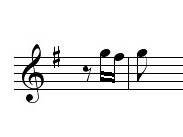
|
|
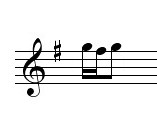
|
|
The opening melody is derived from the first motif and employs Bach's old friend, the composite melody: |
|

|
|
Towards the end of the opening theme, a crucial difference between Bach and Vivaldi is revealed. |
|

|
|
While Vivaldi clearly tries to make the instruments "sing" with hummable melodies, Bach's melodic ideas are defined by the instruments playing it. While the ear accepts the opening theme easily, this music defies any attempt to imitate it vocally. The reason for this is that Bach fully exploits the capabilities of the string instruments, particularly the ability to effortlessly perform large leaps upwards and downwards by moving the bow from one string to another. It gives his music a depth and freshness that Vivaldi's often lacks (Vivaldi did employ such techniques as well, in virtuoso solo passages, but seldom as part of a main theme).
Bach, of course, tacks on the usual melodic postscript at the point where a deceptive cadence appears: |
|

|
|
Something very interesting happens here. Starting from the second measure shown above, Bach introduces a composite melody with an implied pedal tone on the upper G, but in the next measure he "flips" it so that the pedal tone moves down to the D and the mobile part of the composite melody is above it. To put it another way, the mobile part of the melody starts with each note on the downbeat, but then the notes shift over by a quarter beat and become syncopated. The casual listener, of course, would never catch such nuances, but is nevertheless delighted by the effect.
True to Bach's form, the main theme is never quoted exactly the same way twice. He breaks the melody up between instruments, tosses it back and forth between solo and tutti, adds counter-melodies, and varies the consequent phrases. Unlike Vivaldi's piece, there is no clear division between sections. Because the ideas are derived from basic motifs, it is difficult to tell the difference between an independent section and a mere extension of an earlier section. There are a couple of strong unison statements that let the listener know that a boundary has been reached, |
|

|
|
but overall the piece is woven seamlessly together.
In a section built from the second motif, against which the motif in its pure form is repeatedly played, |
|

|
|
Bach displays a classic use of the "harmonic crescendo", reaching its peak late in the piece: |
|

|
|
Here, once again, we get the sense that Bach did not always consider music a vehicle for emotional expression, but believed - and proved - that it can exist for its own sake. The music is very mechanistic, very non-vocal, and yet it is brilliant in its developmental qualities and in its buildup and release of tension. This is absolute music in its purest form, a concept that Fernandez does not seem to grasp.
The use of harmonic crescendo carries the key centers much further afield than in Vivaldi's work. At one point, Bach has turned the key center completely upside down, from the original key of G Major all the way to G minor. From here, a little mode mixture delivers the music easily back to the home key.
Other Differences Between the Two Concertos
There are several important differences in the way the concertos of Bach and Vivaldi were written that are quite enlightening.
- Melodic Range - Vivaldi's opening theme encompasses a range of a major sixth, while Bach's covers a twelfth.
- Instrumental Range - Vivaldi spends more time in the upper registers than Bach does.
- Instrumental Technique - Vivaldi uses techniques like the bowed tremolo and pizzicato more often than Bach does.
The last point could be interpreted to mean that Vivaldi was more imaginative in his instrumental writing. However, it is more likely that the difference in technique, and perhaps in the range as well, was purely a matter of practicality. The Italian violin bow was very different from the German bow favored by Bach. The German bowstring was loose and flexible, while the Italian bow was closer to the stiff, tightly stretched bows used today. Both designs had their advantages and disadvantages. The Italian bow produced a louder tone, while the German bow allowed greater ease in triple and quadruple stopping. The differences in design also allowed for more rapid passages on the Italian bow because of the more ergonomic way in which it was held (the German bow required the performer to be able to tighten and loosen the bowstring with one finger). This difference would have made it extremely difficult to play an effective bowed tremolo with a German bow, and might have also made it tough to switch easily between arco and pizzicato passages. Therefore, these techniques were seen much less often in the music of Bach than in that of Vivaldi. The difference had little to do with the abilities of the two composers, but with the fact that they essentially wrote for different instruments.
I will not analyze the other movements of the concertos, except to say that, while Vivaldi ends with a movement that is strikingly similar to the first one, Bach introduces a contrapuntal gigue. This movement continues with the same somewhat mechanistic, but very entertaining, types of violin passages as in the first movement, but the two movements are starkly different in mood and texture. Whereas Vivaldi has provided unity in his concerto by repeating himself, Bach creates it by very subtle similarities in the instrumental style.
|
| |
|
Conclusions |
|
I believe I have demonstrated that Bach's music is more sophisticated than that of Vivaldi. This Fernandez does not question; however, he did argue that this sophistication gave Bach's music an intellectual dryness that made Vivaldi's refreshing by comparison. I couldn't disagree more. There is no argument sufficient to convince me that Bach is a lesser composer than Vivaldi because he demonstrated vastly greater artistry than his Italian colleague. For inventiveness, skill, and even emotional affect, Vivaldi's music cannot compare with that of Bach. The music of Bach goes far beyond the superficial conception of music as the aping of human emotions. It weaves a universe for itself, independent of the constraining social conventions of Bach's time.
Perhaps this is part of Mr. Fernandez' objections to the music of Bach. If one holds very narrow beliefs about what music should be, then music that falls outside those boundaries would seem jarring, perhaps even disturbing. In such a case, it must be quite comforting to return to the bosom of the sweet, simple melodies of Vivaldi. Fernandez is welcome to do so, but this is a matter of personal preference with no scientific or musicological basis. For Fernandez to claim that Vivaldi's music is greater than Bach's simply because he finds it more comforting is a truly appalling failure of logic. |
| |
|
--John Reese Austin, TX (June 2004) |
|
Feedback to the Article |
|
|